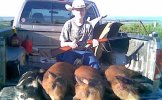I’m out of my area here but no experience with rifles in .45 cal except the .45/70.
However, I do have about $2,000 worth of education on .44 Mag Marlins and their 1:36 slow twist barrels. After owning two Model M1894s, a Model 336 and a Model 1894 tebarreled to a 1:20 twist, I never reached a happy conclusion and gave up.
I had a very similar experience with one of the first M1894s. Using a 429215, I was shooting scoped groups off a bench at 50 yards of an inch. I mean four 5 shot groups. Says I, I got it made and loaded 3 boxes. My son came and we headed to our favorite range for some plinking. On a berm at 70 yards, I couldn’t hit a clay pidgeon or a pop can. 2 foot erratic strikes. Same with the 336 which i still had. Enough! Sent it off and had a rebarrel done with a 1:20 Douglas. My thought were, the SBH handles the 429421 and a 300 grain and my .444 handles the 300 grain so I should be good.
Came back and handled 300s fine. The 429421s okay but not great.
Was winter and Felix Robbin’s and I corresponded back and forth all winter. Swapped bullets, built computer models and theorized. We came to the conclusion that a .44 Mag needed an ideal twist of 1:26 to stabilize both bullets.
Come spring, Winchester brought out its Legacy. More money. When it arrive, I hurried to the range. 429421s in a pile and 300s in a pile about 10” high and to the left at 100 yards. I was a happy camper. This continued for most of the summer. I was satisfied. Didn’t expect both weights to shoot to same point of impact.
Then ugliness raised its head. Started having missfires as did others. Eventually they traced it to a linkage problem with the safety. Winchester didn’t have an immediate fix so I traded off both a .44 Msgnum and a .30/30 Legacy and swore off .44 mag rifles forever.
Comments on the 452423 and 452424.
I have used both in approximately 6 handguns. Both are great out to about 70 yards, The 452424 can be throttled up to make the cut for plinking at 100 yards. The 452490 is a much better mould for long range pistol than either one.
This has been my experiences with a similar situation. Hope it helps.
BTW, the Greenholl formula is no help. It was developed for artillery projectiles and has to be modified for cast.
Before I did anything, I’d try a few jacketed bullets through it.
Bite your tongue, John./beagle

